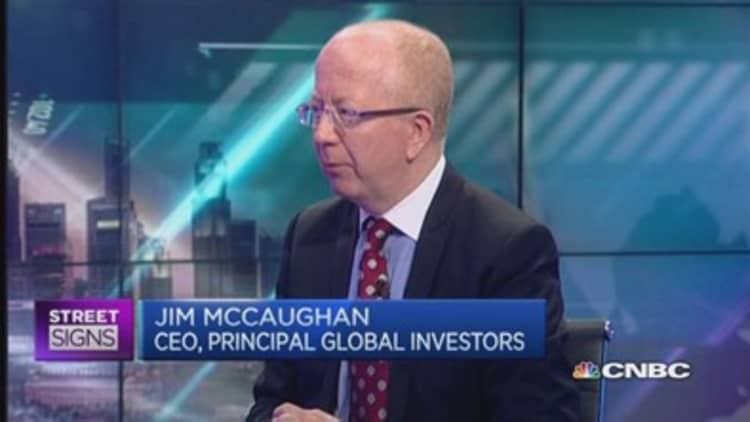Chinese authorities may want the yuan to become a global currency, but they're unlikely to give up control over it any time soon, analysts say.
"The currency band will stay – if they let the yuan trade freely, the Chinese government will lose control over macroeconomic policy," Kenji Yoshikawa, senior economist at Mizuho Securities, told CNBC by phone.
"With the economy slowing, Beijing will want to be in a position to control capital outflows," he said.
Currently, China's central bank sets a daily fixing point from which the yuan can rise or fall by two percent against the U.S. dollar.
Missing element
Beijing's efforts to turn the yuan into a global trading currency by liberalizing capital account controls are paying off: In November, the yuan became the fifth most used global payment currency, according to data from global transaction service SWIFT. In 2014 yuan trade settlements accounted for 20 percent of China's total trade compared with less than 2 percent in 2010, according to Reuters.

And while many analysts expect the yuan's momentum to continue this year, authorities are yet to take a key step in achieving their goal: letting the yuan trade freely.
"Full convertibility will happen at some point – maybe in 2020, when the Chinese government says it wants Shanghai to become a major financial hub ," said ANZ senior FX strategist Khoon Goh by phone. In the meantime, Beijing will widen the band at its own pace, he said.
No currency depreciation
Slowing growth in China has increased speculation that authorities could let the yuan depreciate sharply to boost the competiveness of exports – China's traditional growth driver – which some investors fear could provoke a domino effect of currency depreciations in Asia.
In March, China set its 2015 growth target at "around 7 percent" – the lowest level in 11 years – after the economy expanded its slowest pace in 24 years in 2014.
Meanwhile, the HSBC flash Purchasing Managers' Index released on Tuesday showed that factory activity in the world's second-largest economy dropped to an 11-month low in March.
But analysts say that devaluation fears are misplaced as they don't align with Chinese authorities' aim to move away from manufacturing towards a more service orientated economy.
"The authorities will not depreciate the yuan to stimulate the economy because first, they want the economy to evolve towards a domestic demand-oriented rather than export-dependent economy, and second, there is plenty of room to cut rates," HSBC senior FX strategist Dominic Bunning told CNBC by phone.
Indeed, China has cut interest rates twice since November and reduced the reserve requirement ratios of major banks – the minimum that cash lenders must hold in reserves – once. Recent economic data have raised speculation that more easing is likely.
Next milestone
However, there are a couple of events coming up later this year that could nudge Beijing into widening the yuan trading band, analysts say.
Most important will be the International Monetary Fund's decision on whether the yuan will be included in the Special Drawing Right (SDR) basket of global trading currencies, along with the U.S. dollar, the euro, the yen and the pound sterling. This, analysts say, would further internationalize the yuan.
"There is a good chance the fixed band could be widened before the SDR decision in October or November, to, for example, 3 percent below and above the [daily] fixed rate," said HSBC's Bunning.
Another potential game changer could be MSCI's decision to include China stocks into its global equities indices, according to ANZ's Goh.
None of that is expected to move the yuan much this year, however. For the end of 2015, HSBC's Bunnings sees the dollar-yuan at 6.34, ANZ's Goh forecasts 6.20 and Mizuho's Yoshikawa expects 6.14.
The yuan was quoted at 6.2098 to 6.2109 against the dollar in mid-day trade in Asia on Tuesday.

